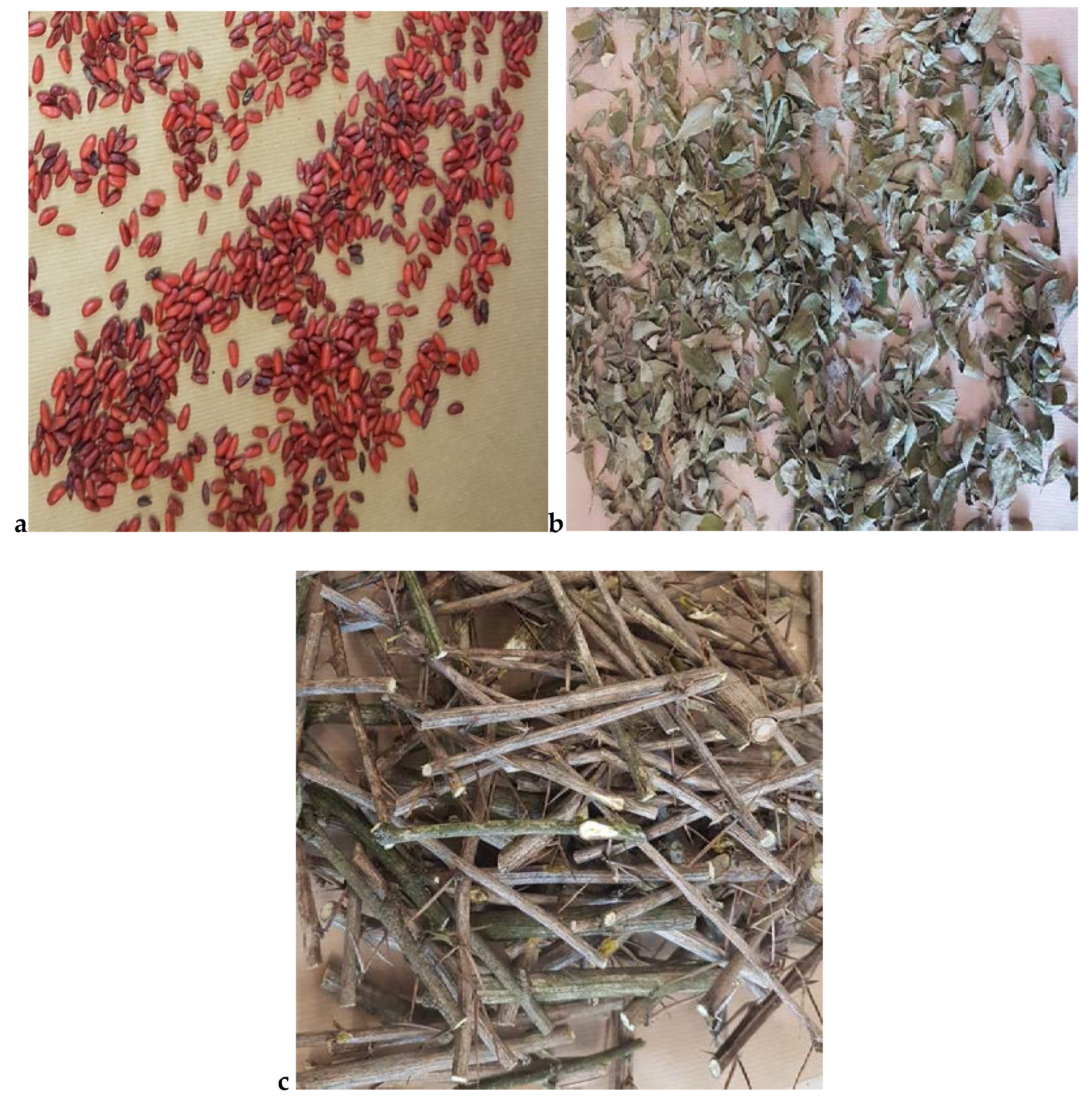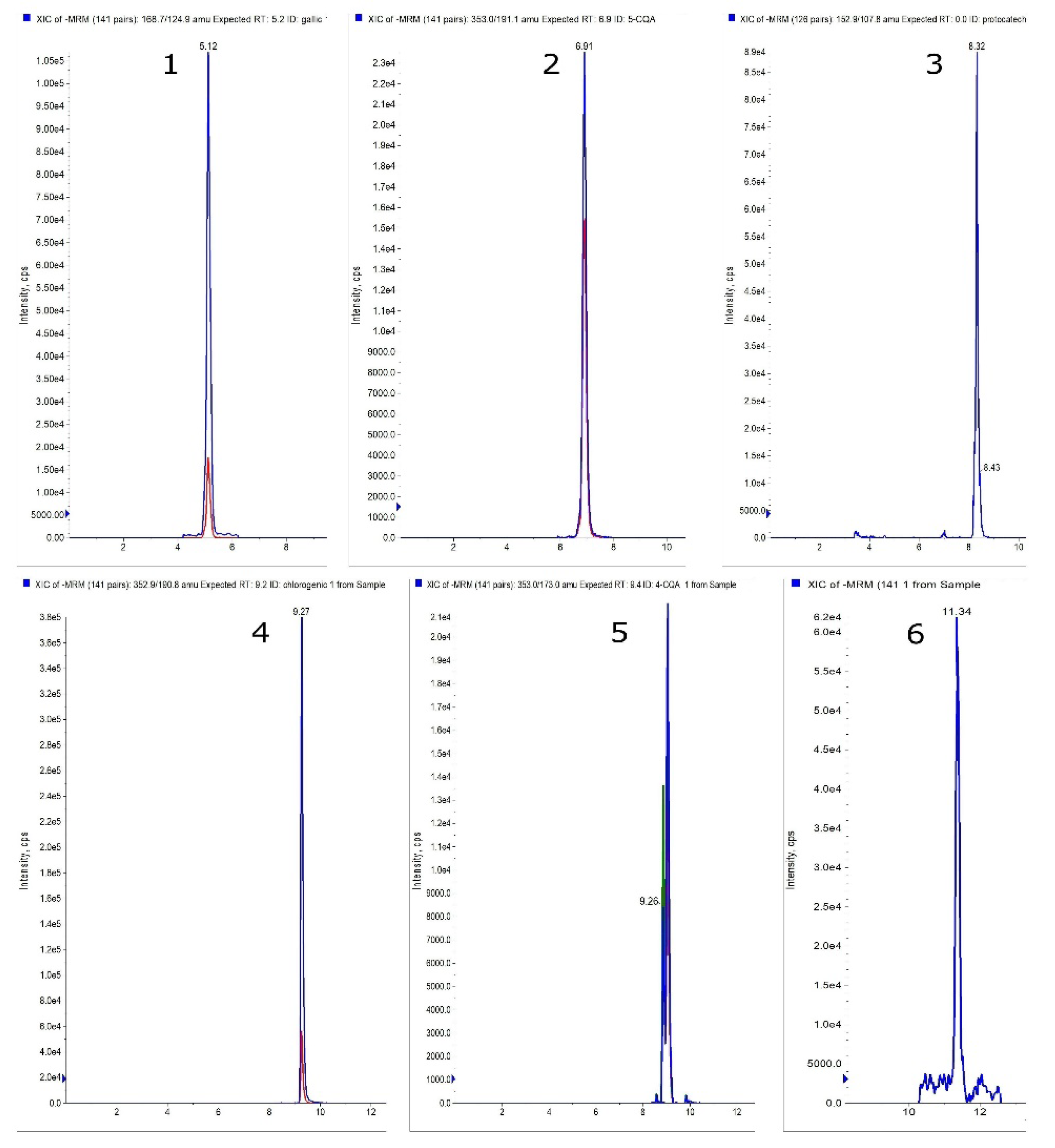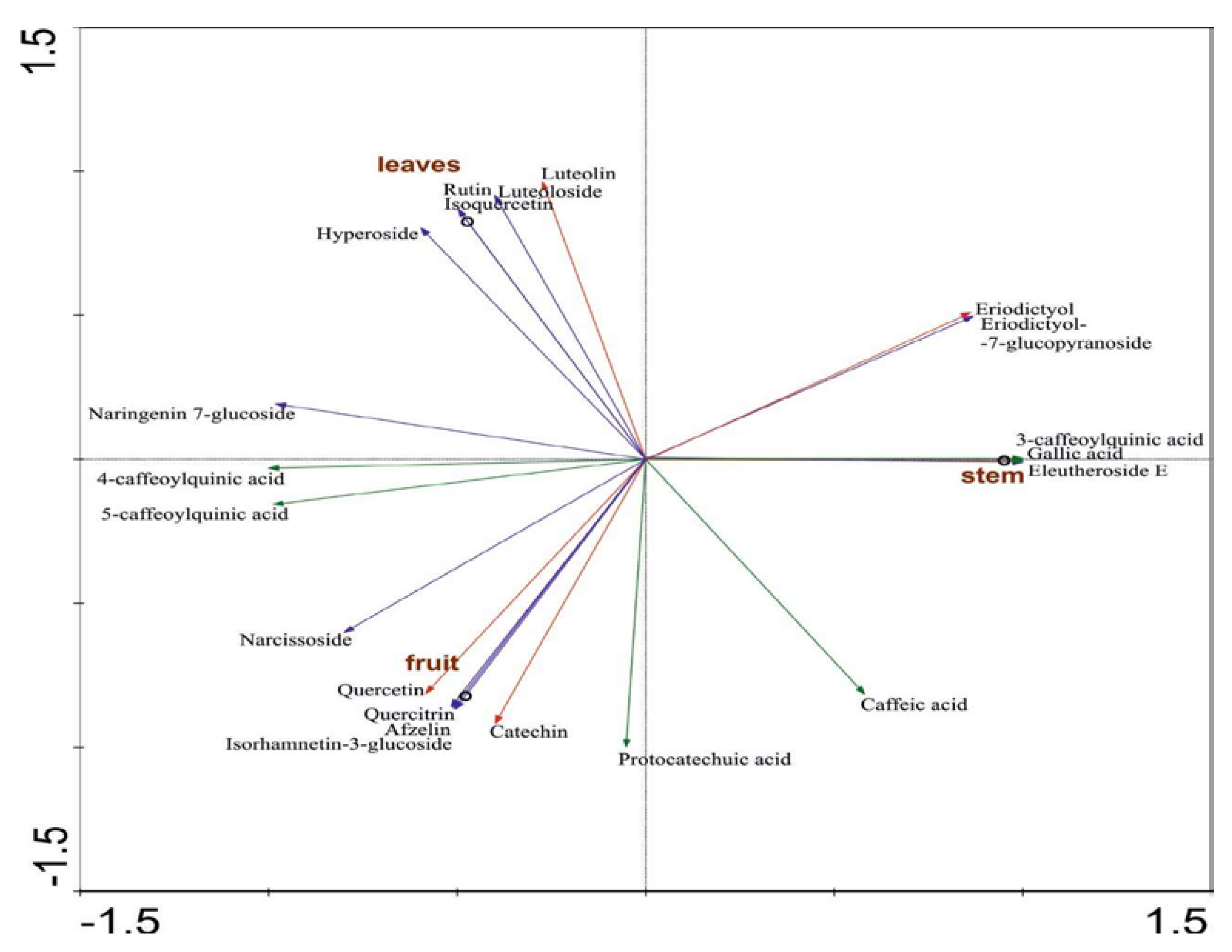Submitted:
17 June 2023
Posted:
19 June 2023
You are already at the latest version
Abstract
Keywords:
1. Introduction
2. Materials and Methods
2.1. Materials and Reagents
2.2. Sample Extraction and Process
2.3. Determination of Total Phenolic, Total Tannins and Total Flavonoid Contents
2.4. Antiradical activity analysis
2.4.1. Determination of Antiradical Potential with the DPPH˚ Assay
2.4.2. Determination of Antiradical Capacity with the ABTS•+ Assay
2.4.3. Oxygen Radical Absorbance Capacity (ORAC) Assay
2.5. Lipoxygenase Inhibitor Screening Assay
2.6. Determination of Phenolic Acids, Flavonoid Glycosides, and Flavonoid Aglycones Using the LC-MS/MS method
3. Results and Discussion
3.1. Polyphenol content in individual organs of Berberis vulgaris
3.2. Quantitative and qualitative analysis of phenolic acids and flavonoids in individual organs of Berberis vulgaris
3.3. Antiradical activity of individual organs of Berberis vulgaris
3.4. Lipoxygenase inhibitory activity of individual organs of Berberis vulgaris
4. Conclusions
Supplementary Materials
Author Contributions
Funding
Institutional Review Board Statement
Informed Consent Statement
Data Availability Statement
Conflicts of Interest
References
- Kukula-Koch, W.; Aligiannis, N.; Halabalaki, M.; Skaltsounis, A.-L.; Glowniak, K.; Kalpoutzakis, E. Influence of Extraction Procedures on Phenolic Content and Antioxidant Activity of Cretan Barberry Herb. Food Chem 2013, 138, 406–413. [Google Scholar] [CrossRef] [PubMed]
- Kukula-Koch, W.; Koch, W.; Angelis, A.; Halabalaki, M.; Aligiannis, N. Application of PH-Zone Refining Hydrostatic Countercurrent Chromatography (HCCC) for the Recovery of Antioxidant Phenolics and the Isolation of Alkaloids from Siberian Barberry Herb. Food Chem 2016, 203, 394–401. [Google Scholar] [CrossRef]
- Sun, J.; Li, Q.; Li, J.; Liu, J.; Xu, F. Nutritional Composition and Antioxidant Properties of the Fruit of Berberis Heteropoda Schrenk. PLoS One 2022, 17, e0262622. [Google Scholar] [CrossRef] [PubMed]
- Abudureheman, B.; Zhou, X.; Shu, X.; Chai, Z.; Xu, Y.; Li, S.; Tian, J.; Pan, H.; Ye, X. Evaluation of Biochemical Properties, Antioxidant Activities and Phenolic Content of Two Wild-Grown Berberis Fruits: Berberis Nummularia and Berberis Atrocarpa. Foods 2022, 11, 2569. [Google Scholar] [CrossRef] [PubMed]
- Karimkhani, M. M.; Salarbashi, D.; Sanjari Sefidy, S.; Mohammadzadeh, A. Effect of Extraction Solvents on Lipid Peroxidation, Antioxidant, Antibacterial and Antifungal Activities of Berberis Orthobotrys Bienerat Ex C.K. Schneider. Journal of Food Measurement and Characterization 2019, 13, 357–367. [Google Scholar] [CrossRef]
- Fernández-Poyatos; Ruiz-Medina; Zengin; Llorent-Martínez. Phenolic Characterization, Antioxidant Activity, and Enzyme Inhibitory Properties of Berberis Thunbergii DC. Leaves: A Valuable Source of Phenolic Acids. Molecules 2019, 24, 4171. [CrossRef]
- Och, A.; Nowak, R. Barberry (Berberis Vulgaris)—Traditional and Contemporary Use; 2021; pp 797–825. [CrossRef]
- Aliakbarlu, J.; Ghiasi, S.; Bazargani-Gilani, B. Effect of Extraction Conditions on Antioxidant Activity of Barberry (Berberis Vulgaris L.) Fruit Extracts. Vet Res Forum 2018, 9, 361–365. [Google Scholar] [CrossRef]
- Eroğlu, A. Y.; Çakır, Ö.; Sağdıç, M.; Dertli, E. Bioactive Characteristics of Wild Berberis Vulgaris and Berberis Crataegina Fruits. J Chem 2020, 2020, 1–9. [Google Scholar] [CrossRef]
- Lin, C.-C.; Ng, L. T.; Hsu, F.-F.; Shieh, D.-E.; Chiang, L.-C. Cytotoxic Effects of Coptis Chinensis and Epimedium Sagittatum Extracts and Their Major Constituents (Berberine, Coptisine and Icariin) on Hepatoma and Leukaemia Cell Growth. Clin Exp Pharmacol Physiol 2004, 31, 65–69. [Google Scholar] [CrossRef]
- El khalki, L.; Tilaoui, M.; Jaafari, A.; Ait Mouse, H.; Zyad, A. Studies on the Dual Cytotoxicity and Antioxidant Properties of Berberis Vulgaris Extracts and Its Main Constituent Berberine. Adv Pharmacol Sci 2018, 2018, 1–11. [Google Scholar] [CrossRef]
- Ghafourian, E.; Sadeghifard, N.; Pakzad, I.; Valizadeh, N.; Maleki, A.; Jafari, F.; Ghiasvand, N.; Abdi, J.; Shokoohinia, Y.; Ghafourian, S. Ethanolic Extract of Berberis Vulgaris Fruits Inhibits the Proliferation of MCF-7 Breast Cancer Cell Line Through Induction of Apoptosis. Infect Disord Drug Targets 2017, 17. [Google Scholar] [CrossRef] [PubMed]
- Zhang, M.; Long, Y.; Sun, Y.; Wang, Y.; Li, Q.; Wu, H.; Guo, Z.; Li, Y.; Niu, Y.; Li, C.; Liu, L.; Mei, Q. Evidence for the Complementary and Synergistic Effects of the Three-Alkaloid Combination Regimen Containing Berberine, Hypaconitine and Skimmianine on the Ulcerative Colitis Rats Induced by Trinitrobenzene-Sulfonic Acid. Eur J Pharmacol 2011, 651, 187–196. [Google Scholar] [CrossRef] [PubMed]
- Ren, K.; Zhang, W.; Wu, G.; Ren, J.; Lu, H.; Li, Z.; Han, X. Synergistic Anti-Cancer Effects of Galangin and Berberine through Apoptosis Induction and Proliferation Inhibition in Oesophageal Carcinoma Cells. Biomedicine & Pharmacotherapy 2016, 84, 1748–1759. [Google Scholar] [CrossRef]
- Wang, K.; Zhang, C.; Bao, J.; Jia, X.; Liang, Y.; Wang, X.; Chen, M.; Su, H.; Li, P.; Wan, J.-B.; He, C. Synergistic Chemopreventive Effects of Curcumin and Berberine on Human Breast Cancer Cells through Induction of Apoptosis and Autophagic Cell Death. Sci Rep 2016, 6, 26064. [Google Scholar] [CrossRef] [PubMed]
- Gîrd, C.E.; Ligiaelena, D.U.; Costea, T.; Nencu, I.; Popescu, M.; Balaci, T.; Olaru, O. Research regarding obtaining herbal extracts with antitumour activity. note ii. phytochemical analysis, antioxidant activity and cytotoxic effects of Chelidonium majus L., Medicago sativa l. and Berberis vulgaris L. dry extracts.
- Gorizpa, M.; Bahmanyar, F.; Mirmoghtadaie, L.; Shafaei, F. Evaluation of Antioxidant and Antiµbial Properties of Root and Stem Bark Extracts of Three Species of Barberry in Bread. Journal of Research and Innovation in Food Science and Technology 2022, 10, 413–426. [Google Scholar] [CrossRef]
- El-Zahar, K. M.; Al-Jamaan, M. E.; Al-Mutairi, F. R.; Al-Hudiab, A. M.; Al-Einzi, M. S.; Mohamed, A. A.-Z. Antioxidant, Antibacterial, and Antifungal Activities of the Ethanolic Extract Obtained from Berberis Vulgaris Roots and Leaves. Molecules 2022, 27, 6114. [Google Scholar] [CrossRef] [PubMed]
- Singleton. Colorimetry of Total Phenolics with Phosphomolybdic-Phosphotungstic Acid Reagents.
- Price, M.L.; Scoyoc, S.V.; Butler, L.G. A critical evaluation of the vanillin reaction as an assay for tannin in sorghum grain. J. Agric. Food Chem. 1978, 26, 1214–1218. [Google Scholar] [CrossRef]
- Brand-Williams, W.; Cuvelier, M. E.; Berset, C. Use of a Free Radical Method to Evaluate Antioxidant Activity. LWT - Food Science and Technology 1995, 28, 25–30. [Google Scholar] [CrossRef]
- Olech, M.; Łyko, L.; Nowak, R. Influence of Accelerated Solvent Extraction Conditions on the LC-ESI-MS/MS Polyphenolic Profile, Triterpenoid Content, and Antioxidant and Anti-Lipoxygenase Activity of Rhododendron Luteum Sweet Leaves. Antioxidants 2020, 9, 822. [Google Scholar] [CrossRef]
- Pieczykolan, A.; Pietrzak, W.; Nowak, R.; Pielczyk, J.; Łamacz, K. Optimization of Extraction Conditions for Determination of Tiliroside in Tilia L. Flowers Using an LC-ESI-MS/MS Method. J Anal Methods Chem 2019, 2019, 1–9. [Google Scholar] [CrossRef]
- Re, R.; Pellegrini, N.; Proteggente, A.; Pannala, A.; Yang, M.; Rice-Evans, C. Antioxidant Activity Applying an Improved ABTS Radical Cation Decolorization Assay. Free Radic Biol Med 1999, 26, 1231–1237. [Google Scholar] [CrossRef] [PubMed]
- Huang, D.; Ou, B.; Hampsch-Woodill, M.; Flanagan, J. A.; Prior, R. L. High-Throughput Assay of Oxygen Radical Absorbance Capacity (ORAC) Using a Multichannel Liquid Handling System Coupled with a µplate Fluorescence Reader in 96-Well Format. J Agric Food Chem 2002, 50, 4437–4444. [Google Scholar] [CrossRef]
- Baraniak, B.; Szymanowska, U. Lipooxygenase in Food of Plant Origin. Żywność Nauka Technologia Jakość 2006, 2, 29–45. [Google Scholar]
- Łyko, L.; Olech, M.; Nowak, R. LC-ESI-MS/MS Characterization of Concentrated Polyphenolic Fractions from Rhododendron Luteum and Their Anti-Inflammatory and Antioxidant Activities. Molecules 2022, 27, 827. [Google Scholar] [CrossRef] [PubMed]
- Motalleb, G. , Hanachi P.; Kua, S.H. Evaluation of Phenolic Contentand Total Antioxidant Activity in Berberis Vulgaris Fruit Extracts. Journal of Biological Science 2005, 5, 648–653. [Google Scholar] [CrossRef]
- Dimitrijević, M. v.; Mitić, V. D.; Ranković, G. Ž.; Miladinović, D. L. Survey of Antioxidant Properties of Barberry: A Chemical and Chemometric Approach. Anal Lett 2020, 53, 671–682. [Google Scholar] [CrossRef]
- Khromykh, N. O.; Lykholat, Y. v.; Kovalenko, I. M.; Kabar, A. M.; Didur, O. O.; Nedzvetska, M. I. Variability of the Antioxidant Properties of Berberis Fruits Depending on the Plant Species and Conditions of Habitat. Regul Mech Biosyst 2018, 9, 56–61. [Google Scholar] [CrossRef]
- Okatan, V.; Çolak, A. M. Chemical and Phytochemicals Content of Barberry (Berberis Vulgaris L.) Fruit Genotypes from Sivasli District of Usak Province of Western Turkey. Pak J Bot 2019, 51. [Google Scholar] [CrossRef]
- Gholizadeh-Moghadam, N.; Hosseini, B.; Alirezalu, A. Classification of Barberry Genotypes by Multivariate Analysis of Biochemical Constituents and HPLC Profiles. Phytochemical Analysis 2019, 30, 385–394. [Google Scholar] [CrossRef]
- Sharifi, A.; Niakousari, M.; Mortazavi, S. A.; Elhamirad, A. H. High-Pressure CO2 Extraction of Bioactive Compounds of Barberry Fruit (Berberis Vulgaris): Process Optimization and Compounds Characterization. Journal of Food Measurement and Characterization 2019, 13, 1139–1146. [Google Scholar] [CrossRef]
- Mariod, A. A.; Ibrahim, R. M.; Ismail, M.; Ismail, N. Antioxidant Activities of Phenolic Rich Fractions (PRFs) Obtained from Black Mahlab (Monechma Ciliatum) and White Mahlab (Prunus Mahaleb) Seedcakes. Food Chem 2010, 118, 120–127. [Google Scholar] [CrossRef]
- Imanshahidi, M.; Hosseinzadeh, H. Pharmacological and Therapeutic Effects of Berberis Vulgaris and Its Active Constituent, Berberine. Phytotherapy Research 2008, 22, 999–1012. [Google Scholar] [CrossRef] [PubMed]
- Nova-Baza, D.; Olivares-Caro, L.; Bustamante, L.; Pérez, A. J.; Vergara, C.; Fuentealba, J.; Mardones, C. Metabolic Profile and Antioxidant Capacity of Five Berberis Leaves Species: A Comprehensive Study to Determine Their Potential as Natural Food or Ingredient. Food Research International 2022, 160, 111642. [Google Scholar] [CrossRef] [PubMed]
- Movahedi. Evaluation of Antioxidant Activity, Total Phenolic and Flavonoids Contents of Orthosiphon Stamineus, Teucrium Polium, and Berberis Vulgaris Decoctions.
- Kalmarzi, R. N.; Naleini, S. N.; Ashtary-Larky, D.; Peluso, I.; Jouybari, L.; Rafi, A.; Ghorat, F.; Heidari, N.; Sharifian, F.; Mardaneh, J.; Aiello, P.; Helbi, S.; Kooti, W. Anti-Inflammatory and Immunomodulatory Effects of Barberry ( Berberis Vulgaris ) and Its Main Compounds. Oxid Med Cell Longev 2019, 2019, 1–10. [Google Scholar] [CrossRef] [PubMed]



| EE | TPC | TTC | TFC | |
|---|---|---|---|---|
| Stem | 9.1 | 57.72±0.00 | 4.53±0.00 | 4.57±0.01 |
| Leaves | 20.46 | 58.52±0.01 | 4.6±0.00 | 15.32±0.08 |
| Fruits | 35.72 | 52.77±0.01 | 17.1±0.04 | 6.11±0.02 |
| Sample | Berberis stem | Berberis fruits | Berberis leaves |
|---|---|---|---|
| Phenolic acids | |||
| Gallic acid | 10.48±0.19 | < LOQ | nd |
| 3-caffeoylquinic acid | 2.39±0.09 | nd | <LOQ |
| Protocatechuic acid | 54.99±1.11 | 120.5±6.37 | nd |
| 5-caffeoylquinic acid | 175.56±5.57 | 3049.24±17.87 | 2556.43±47.65 |
| 4-caffeoylquinic acid | 0.44±0.01 | 25.73±0.46 | 25.09±0.39 |
| Caffeic acid | 252.71±6.36 | 237.45±8.99 | 105.35±3.92 |
| Sum of phenolic acids | 496.57 | 3432.93 | 2686.88 |
| Flavonoid aglycones | |||
| Catechin | 46.75±1.43 | 372.16±0.71 | nd |
| Luteolin | 2.96±0.21 | 0.33±0.01 | 11.98±0.27 |
| Quercetin | < LOQ | 19.44±0.5 | 1.57±0.06 |
| Eriodictyol | 3.97±0.09 | 0.36±0.01 | 1.64±0.04 |
| Flavonoid glycosides | |||
| Eleutheroside E | 116.20±1,86 | nd | nd |
| Eriodictyol-7-glucopyranoside | 3.97±0.09 | 0.36±0.01 | 1.63±0.037 |
| Rutin | < LOQ | < LOQ | 263.37±8.46 |
| Hyperoside | 38.86±1.07 | 282.91±6.71 | 1942.24±47.39 |
| Luteoloside | 11.37±0.40 | nd | 92.53±0.7 |
| Isoquercetin | <LOQ | <LOQ | 536.30±10.98 |
| Narcissoside | nd | 46.33±0.33 | 17.77±0.36 |
| Isorhamnetin-3-glucoside | nd | 44.08±0.18 | <LOQ |
| Quercitrin | 8.89±0.22 | 1112.69±21.69 | 9.48±0.25 |
| Naringenin 7-glucoside | nd | 3.81±0.15 | 4.54±0.08 |
| Afzelin | < LOQ | 261,6±0,41 | < LOQ |
| Sum of flavonoids | 229.01 | 2143.70 | 2881.43 |
| Sample | ABTS [mgTE/g] |
ORAC [mgTE/g] |
DPPH [mgTE/g] |
|---|---|---|---|
| Stem Leaves Fruits |
122.96±001 140.49±0.04 117.93±0.01 |
167.70±0.04 267.81±0.03 215.25±0.02 |
63.88±0.001 65.25±0.005 64.73±0.008 |
| Sample | % LOX inhibition |
| Stem Leaves Fruits |
83.57±0.13a 79.78±2.19a 45.24±2.45b |
| ABTS | ORAC | DPPH | % LOX Inhibition | |
|---|---|---|---|---|
| TPC | 1 | 1 | 1 | 1 |
| TFC | 1 | 1 | 1 | 1 |
| Sum of phenolic acids | -1 | -1 | -1 | -1 |
| Sum of Flavonoids | 1 | 1 | 1 | 1 |
| Protocatechuic acid | -1 | -1 | -1 | -1 |
| 5-caffeoylquinic acid | -1 | -1 | -1 | -1 |
| 4-caffeoylquinic acid | -1 | -1 | -1 | -1 |
| Caffeic acid | -1 | -1 | -1 | -1 |
| Catechin | -1 | -1 | -1 | -1 |
| Luteolin | 1 | 1 | 1 | 1 |
| Eriodictyol | 1 | 1 | 1 | 1 |
| Quercetin | -1 | -1 | -1 | -1 |
| Hyperoside | 1 | 1 | 1 | 1 |
| Luteoloside | 1 | 1 | 1 | 1 |
| Naringenin 7-glucoside | 1 | 1 | 1 | 1 |
| Narcissoside | 1 | 1 | 1 | 1 |
| Quercitrin | 1 | 1 | 1 | 1 |
Disclaimer/Publisher’s Note: The statements, opinions and data contained in all publications are solely those of the individual author(s) and contributor(s) and not of MDPI and/or the editor(s). MDPI and/or the editor(s) disclaim responsibility for any injury to people or property resulting from any ideas, methods, instructions or products referred to in the content. |
© 2023 by the authors. Licensee MDPI, Basel, Switzerland. This article is an open access article distributed under the terms and conditions of the Creative Commons Attribution (CC BY) license (http://creativecommons.org/licenses/by/4.0/).





